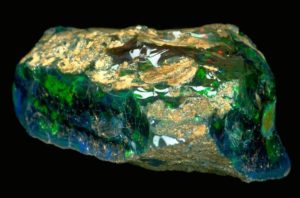
Roebling Opal
The Roebling Opal, discovered in Humboldt County’s Virgin Valley, was donated to the Smithsonian in 1917. The 1.5 pound black fire opal is considered one of the museum’s most impressive specimens.
The Opal was named for its creator Colonel Washington Augustus Roebling who is in the Smithsonian Museum of Natural History ‘s permanent collection of the same name.
The Roebling Opal, from Virgin Valley, Nevada, is an exceptional 2,585ct opal rough piece. The opal was deposited in voids from silica-rich water that existed after buried tree limbs had rotted away, In some cases to opal casts of the original parts of the tree. Although extremely beautiful, opal is not commonly used in jewellery from this location because it tends to crack or crack. Opals with a vivid play-of-color and a black or other dark body color are called black opals. The Roebling Opal is a black opal with flashes of blue and green play-of-color.
This opalised log from Nevada is one of the many treasures in the Smithsonian National Gem Collection. For several millions of years Western USA has been the site of plentiful volcanism and associated hydrothermal systems, and because much of it is silica-rich, there is plenty of raw material for mineralized waters to create these parts by replacing buried and rotted trees and logs, the Petrified Forest in Arizona being a popular example (though unfortunately agatised rather than opalised).
What Is Opal?
Opal is a hydrated amorphous form of silica; its water content may range from 3 to 21% by weight, but is usually between 6 and 10%. Because of its amorphous character, it is classed as a mineraloid, unlike the other crystalline forms of silica, which are classed as minerals. It is deposited at a relatively low temperature and may occur in the fissures of almost any kind of rock, being most commonly found with limonite, sandstone, rhyolite, marl, and basalt.
Opal is the national gemstone of Australia. Australian opal has often been cited as accounting for 95-97% of the world’s supply of precious opal, with the state of South Australia accounting for 80% of the world’s supply. Recent data suggests that the world supply of precious opal may have changed. In 2012, Ethiopian opal production was estimated to be 14,000 kg (31,000 lb) by the United States Geological Survey. USGS data from the same period (2012), reveals that Australian opal production to be $41 million. Because of the units of measurement, it is not possible to directly compare Australian and Ethiopian opal production, but these data and others suggest that the traditional percentages given for Australian opal production may be overstated. Yet, the validity of data in the USGS report appears to conflict with that of Laurs and others and Mesfin, who estimated the 2012 Ethiopian opal output (from Wegal Tena) to be only 750 kg (1,650 lb).
Read more : What Is Opal?










